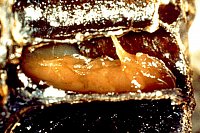Mapping honeybee resistance genes against American Foulbrood (AFB).

American Foulbrood is a honeybee-specific brood disease that is caused by the spore-forming bacterium Paenbacillus larvae. It infects only very young larvae and kills them degrading their tissues to a brownish sticky mass (see picture), leaving highly contagious dry scales in the brood cells. Larvae that are older than 48 hours and adult bees are completely immune to the disease but act as vectors to spread the infectious spores within and between colonies. Since infected colonies can’t produce viable offspring they usually die out. Therefore AFB is an exception among bee diseases and is considered to be the most destructive of the brood diseases because it kills not only individuals but whole colonies.
Although AFB causes great economic losses to beekeeping there is no established method or treatment to control the disease and infected colonies usually have to be burned to prevent infection to be carried to surrounding colonies.
Honeybee resistance against AFB
Already since the 1930s it is known that honeybee lines differ in their resistance against AFB. These differences could be ascribed to differences in the efficiency of hygienic behaviour (removal of dead brood) of worker bees, to morphological traits of the workers, to foraging preferences and to various compounds in the larval food.
Apart from these resistances on colony level it is also proven that larvae do have an innate resistance, and that larvae of resistant lines become immune to the disease at younger ages than larvae from susceptible lines. The heritability of these traits shows clearly that AFB resistance has a genetic basis.
In order to identify lines of high and low resistance we rear drone larvae of different honeybee lines under controlled in vitro conditions in the incubator and expose them to various doses of AFB spores. Using this method we exclude all factors that are known to influence AFB resistance like nurse bees and food compounds.
By using haploid drones we are able to detect genetic variance very easy and with a high resolution since we exclude all interactions between homologous alleles.
Mapping resistance genes
Having identified resistant and susceptible lines we take advantage of male haploidy, the high recombination rate in honeybees and the availability of numerous genetic microsatellite markers for honeybees, to determine the location of genes that influence resistance.
We pool DNA material of the drones with an identical phenotype. Since we know the location of the microsatellite markers in the genome and physically linked markers will be inherited together with the resistance allele, we are able to locate resistance genes by finding differences in allele frequencies in the pools. Similar techniques have been widely used to identify disease genes in human populations.
By identifying the position, the function and the transcription pattern of these genes we hope to get new insights into infection mechanisms which will enable us to break disease pathways and design ecologically friendly methods for the control of AFB.
The development of diagnostic markers (e.g. SNPs) for different alleles of these genes will furthermore facilitate breeding of AFB resistant honeybee lines.
This work is part of the EU-network BEESHOP.



